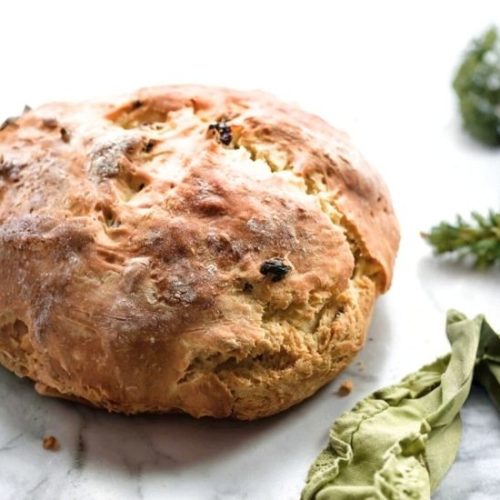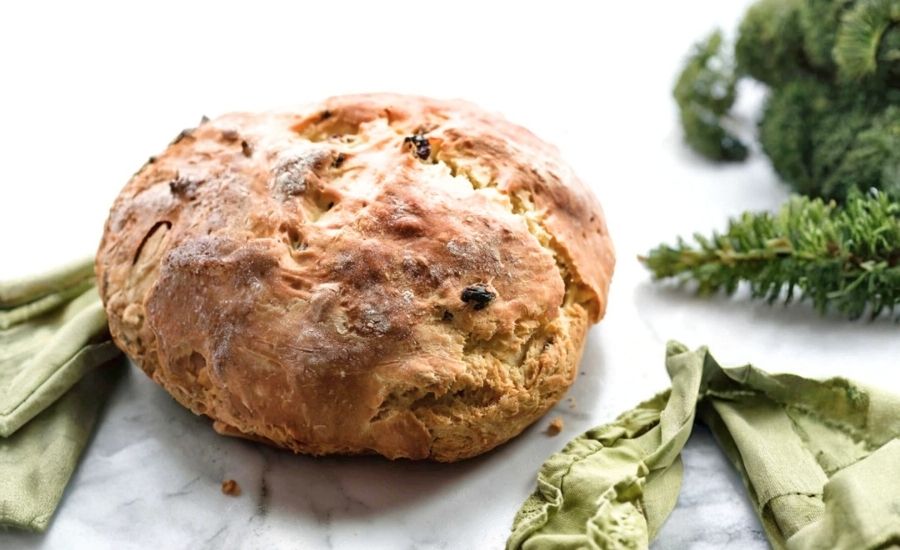All products are selected by our editorial team for quality. If you buy through our links, we may earn a small commission at no extra cost to you.
Grandma’s Irish Soda Bread stands out as a timeless classic that combines simplicity with rich, comforting flavors.
Unlike traditional yeast breads, this recipe uses baking soda and buttermilk for leavening, making it incredibly quick and easy to prepare without compromising texture or taste.
The bread’s dense yet tender crumb, paired with its signature crusty exterior, offers a satisfying contrast that appeals to bread lovers everywhere.
Nutritionally, it benefits from the use of buttermilk, which provides a good source of protein and calcium, while the absence of yeast and extended rising times makes it a practical choice for everyday cooking.
The optional inclusion of raisins adds natural sweetness and a fiber boost.
This bread is versatile for breakfast, snacks, or alongside hearty meals, and it’s meal-prep friendly since it freezes well and reheats beautifully.
Whether you’re a novice or an experienced baker, this recipe delivers reliable, delicious results with minimal fuss.
Must-Have Tools for Perfect Results
Cast Iron Skillet
Ideal for baking this bread, a cast iron skillet provides even heat distribution that promotes a beautifully crisp crust and moist interior.
Beyond soda bread, it’s a versatile kitchen workhorse perfect for searing, roasting, and sautéing.
Instant-Read Thermometer
Ensures your bread is perfectly baked by accurately measuring the internal temperature, preventing underbaking or overbaking.
This tool is indispensable for all baking and cooking precision.
Pastry Cutter
Used to cut cold butter into the flour, creating pea-sized crumbs that enhance the bread’s flaky texture. It’s also great for making pie crusts and biscuits.
Bread Lame or Sharp Knife
Scoring the dough with a lame or sharp knife helps control expansion and creates an attractive crust pattern.
It’s a small tool with a big impact on presentation.
Mixing Bowl
A large, sturdy mixing bowl makes combining ingredients effortless and mess-free.
High-quality bowls serve multiple kitchen purposes from mixing to marinating.

Irish Soda Bread
Equipment
- 1 large mixing bowl
- 1 Whisk
- 1 pastry cutter (or fork/fingers for butter cutting)
- 1 sharp knife or bread lame for scoring
- 1 baking vessel (cast iron skillet, baking sheet with parchment/silicone mat, cake pan, pie dish, or Dutch oven)
- 1 instant-read thermometer (optional but recommended)
Ingredients
- 1 ¾ cups 420 ml cold buttermilk*
- 1 large egg optional, see notes
- 4 ¼ cups 531 g all-purpose flour, plus extra for dusting
- 3 tablespoons 38 g granulated sugar
- 1 teaspoon baking soda
- 1 teaspoon fine salt
- 5 tablespoons 71 g unsalted butter, very cold and cut into small cubes
- 1 cup 150 g raisins (optional)
Instructions
- Prepare Oven and Baking Vessel: Preheat your oven to 400°F (204°C). Choose your baking method: line a baking sheet with parchment paper or a silicone mat, or lightly grease a 10–12 inch cast iron skillet, a 9–10 inch cake pan, pie dish, or a large Dutch oven (if using, bake uncovered). Avoid loaf pans to ensure even baking and a nice flat shape.
- Mix Wet Ingredients: In a medium bowl, whisk together the cold buttermilk and the egg until fully combined. Set this mixture aside while you prepare the dry ingredients.
- Combine Dry Ingredients and Incorporate Butter: In a large mixing bowl, sift together the flour, sugar, baking soda, and salt. Add the cold butter cubes to the flour mixture. Using a pastry cutter, two forks, or your fingertips, work the butter into the flour until the texture resembles coarse crumbs roughly the size of peas.
- Add Raisins and Blend Wet Ingredients: If using, stir the raisins into the flour and butter mixture. Pour the buttermilk and egg mixture into the dry ingredients. Using a sturdy spoon or your hands, gently fold the ingredients together until the dough just begins to come together and becomes too stiff to stir easily.
- Knead Dough Gently: Transfer the dough to a lightly floured surface. Sprinkle a little flour on your hands and knead the dough briefly—about 30 seconds—just until all the flour is moistened and a cohesive ball forms. If the dough feels too sticky, dust with a bit more flour, but be careful not to overdo it.
- Shape and Score Dough: Place the dough ball into your prepared baking vessel. Using a very sharp knife or bread lame, score an “X” shape about ½ inch deep into the top of the dough. This scoring allows steam to escape and helps the bread bake evenly.
- Bake Until Golden and Done: Bake in the preheated oven for 45 to 55 minutes, or until the bread has a golden-brown crust and sounds hollow when tapped on the bottom. To be precise, use an instant-read thermometer; the internal temperature should reach 195°F (90°C). If the top browns too quickly, tent the bread loosely with aluminum foil.
- Cool and Serve: Remove the bread from the oven and allow it to cool for about 10 minutes before transferring to a wire rack. Serve warm, at room temperature, or toasted with your favorite spreads.
Notes
- Buttermilk Substitute: If you don’t have buttermilk, combine 1 tablespoon of white vinegar or lemon juice with enough cold whole or 2% milk to make 1 ¾ cups. Stir and let it sit for 5 minutes before using.
- Egg Optionality: The egg enriches the dough and adds slight density but can be omitted for a lighter bread with no other changes needed.
- Butter Temperature: Use very cold butter, even partially frozen, to keep the dough from becoming sticky and to ensure a tender crumb with a flaky texture.
- Baking Vessel Choice: This bread bakes best as a round, flatter loaf rather than in a traditional loaf pan to allow even cooking throughout.
- Storage: Store leftover bread wrapped tightly in foil at room temperature for up to 2 days or refrigerate for up to 1 week. It also freezes well, either whole or sliced, for up to 3 months.
- Smaller Loaves: To make multiple smaller loaves, divide the dough accordingly. Adjust baking time based on size and always check with a thermometer to confirm doneness.
Chef’s Secrets for Irresistible Bread
Achieving the perfect Irish soda bread is all about mastering a few simple yet crucial details.
First, always use cold buttermilk and cold butter — this combination ensures the bread rises properly and develops that tender, flaky texture.
When cutting the butter into the flour, aim for pea-sized bits; this creates pockets of buttery goodness that give the bread a wonderful crumb.
Don’t overmix the dough; it should be just combined and a bit sticky — overworking will lead to a tough loaf. Scoring the dough deeply allows steam to escape and helps the bread expand evenly during baking, resulting in a beautiful crust.
Finally, baking in a cast iron skillet or Dutch oven produces an exceptional crust thanks to even heat retention, but a lined baking sheet works well too.
Use an instant-read thermometer to avoid guesswork and bake until the internal temperature hits 195°F (90°C) for perfectly cooked bread every time.
Serving Suggestions to Enhance Enjoyment
This Irish soda bread shines best when served warm, allowing its crusty exterior and soft crumb to be fully appreciated.
It pairs wonderfully with a pat of butter and a drizzle of honey or jam for a simple breakfast treat.
For a savory twist, slice and toast it alongside hearty soups like Irish stew, vegetable chowder, or creamy potato soup.
It also makes an excellent base for open-faced sandwiches topped with smoked salmon, cream cheese, or sharp cheddar.
Leftover slices toasted and topped with scrambled eggs or avocado create a satisfying brunch option.
For festive occasions, serve alongside a cheese board featuring sharp cheddar, Irish porter cheese, and cured meats to elevate your spread.
The bread’s dense texture makes it ideal for soaking up stews and gravies, so don’t hesitate to pair it with rich, comforting dishes.
Storage Tips for Lasting Freshness
To keep your Irish soda bread fresh and flavorful, wrap it tightly in aluminum foil or place it in an airtight container once cooled.
At room temperature, it will stay good for up to two days without drying out.
For longer storage, refrigeration extends freshness to about one week, but be aware this can slightly dry the bread, so warming before serving is recommended.
The best way to preserve leftovers is freezing — wrap the whole loaf or individual slices in plastic wrap and then foil or place in a freezer-safe bag. Frozen bread keeps well for up to three months.
When ready to enjoy, thaw at room temperature or gently reheat in the oven to restore its crusty exterior and soft inside.
Avoid slicing before freezing unless you want convenient grab-and-go portions for quick breakfasts or snacks.
Frequently Asked Questions Answered
1. Can I make this bread without buttermilk?
Yes! You can create a buttermilk substitute by mixing 1 tablespoon of lemon juice or white vinegar with enough cold milk to total 1 ¾ cups.
Let it sit for 5 minutes before using. This mimics the acidity of buttermilk needed to activate the baking soda.
2. Is the egg necessary in the recipe?
The egg is optional. It adds richness and slight density but can be omitted for a lighter loaf without impacting the bread’s rise or flavor significantly.
3. Why shouldn’t I use a loaf pan?
This dough is best baked as a round, flatter loaf to ensure even cooking and a crusty exterior. Loaf pans tend to produce uneven baking with a soggy center.
4. How can I tell when the bread is done?
Use an instant-read thermometer to check the internal temperature, which should reach 195°F (90°C).
The bread should sound hollow when tapped on the bottom and have a golden-brown crust.
5. Can I add other ingredients besides raisins?
Absolutely! You can customize your bread with dried cranberries, chopped nuts, or even herbs like rosemary.
Just keep additions to about 1 cup total so the dough remains balanced.
This recipe is inspired by sallysbakingaddiction and has been carefully refined to enhance clarity, streamline preparation steps, and ensure accurate results. We’ve also included health benefits, nutritional highlights, and Must-Have Tools to help you get the best results every time you cook.


